No bread flour? No problem! Learn how to make artisan sourdough bread with all purpose flour instead, naturally leavened with active sourdough starter. This post includes a practical, no-nonsense guide with step-by-step photos, instructions and baking schedule.
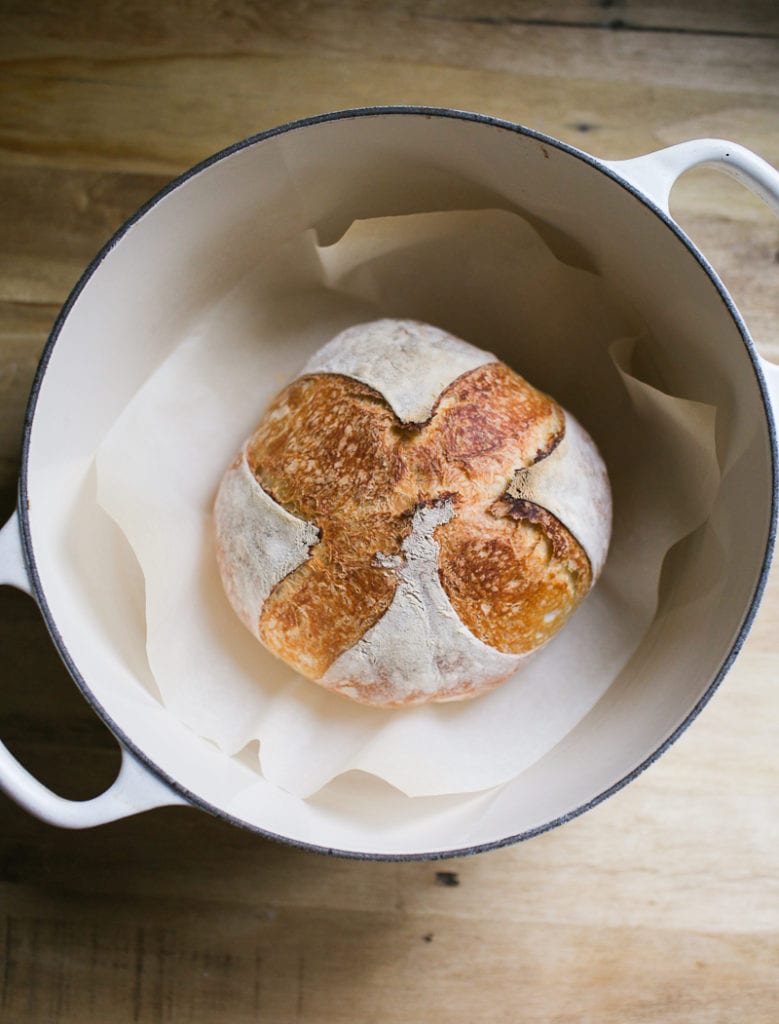
Bakers all over the world insist on using bread flour to create incredible homemade sourdough bread. It’s prized for its high protein and gluten content, which typically gives sourdough bread recipes a lofty, high rise. But what if you don’t have any bread flour? Can you make crusty, artisan sourdough with all purpose flour instead?
The answer is yes, you most certainly can! But in my experience, you’ll have to make additional adjustments as you go along- you can’t just swap one flour for another. In this post, I’ll explain the process step-by-step. You’ll gain the tools and confidence you need to make incredible sourdough bread with all purpose flour (and for my UK & Aussie readers that’s “plain flour” for you!).
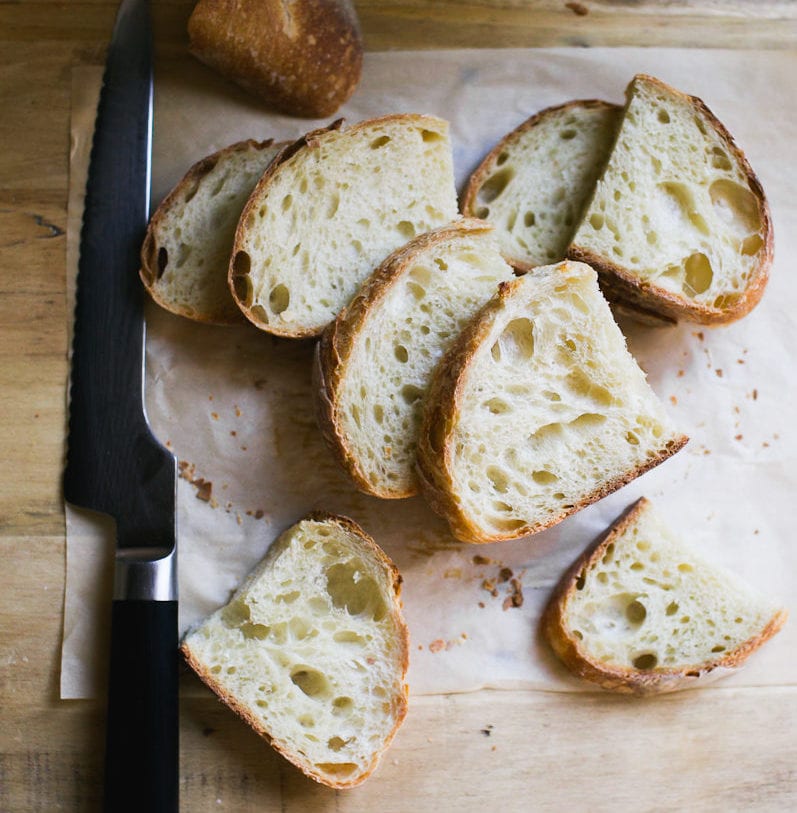
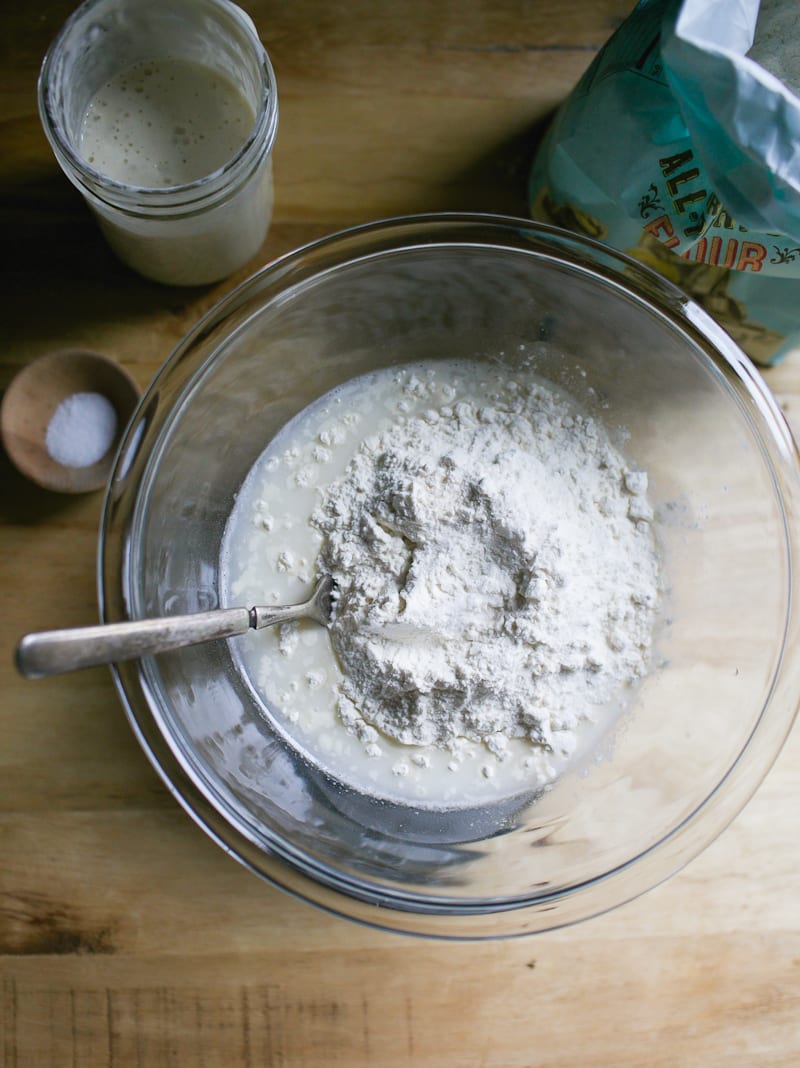
All Purpose Flour vs. Bread flour: What’s The Difference?
Generally speaking, it all boils down to protein content.
When compared side by side, bread flour has a higher protein content than all purpose flour.
High protein = better gluten development, which in most cases yields a higher rise.
I typically use King Arthur flour for bread baking. Their bread flour contains 12.7% protein, and their all purpose flour contains 11.7%.
This recipe was formulated to work with KAF all purpose flour and Trader Joe’s all purpose flour (which in my opinion, is comparable). I talk more about flour in this post.
TIP: Protein content will vary across the board. This means you’ll get different results from brand to brand. I highly recommend sticking with ONE BRAND at first. This way, you’ll get a feel for how that specific flour performs; it will be your reference point for future adjustments.
How to Use All Purpose Flour in Bread Baking
Substituting all purpose flour in a sourdough recipe that specifically calls for bread flour is not always an even swap.
You’ll need to REDUCE the total amount of water first.
All purpose flour absorbs less water than bread flour, which can make the dough too sticky to work with otherwise.
This can lead to flat, dense, and gummy loaves. You don’t want that.
Ok, So Reduce the Water by How Much?
I typically suggest reducing the water by 15-30g to start.
Why the range?
It depends on the recipe, how much starter it calls for, and what brand of flour you’re using etc.
You’ll have to play around with the texture of the dough, adjusting the flour/water until it “feels right,” which can be frustrating if you just don’t have the experience.
It requires practice, patience and persistence.
So, for now, let’s focus on the visual and tactile tools to help guide you instead.
How to Make Artisan Sourdough with All Purpose Flour: A Step By Step Guide
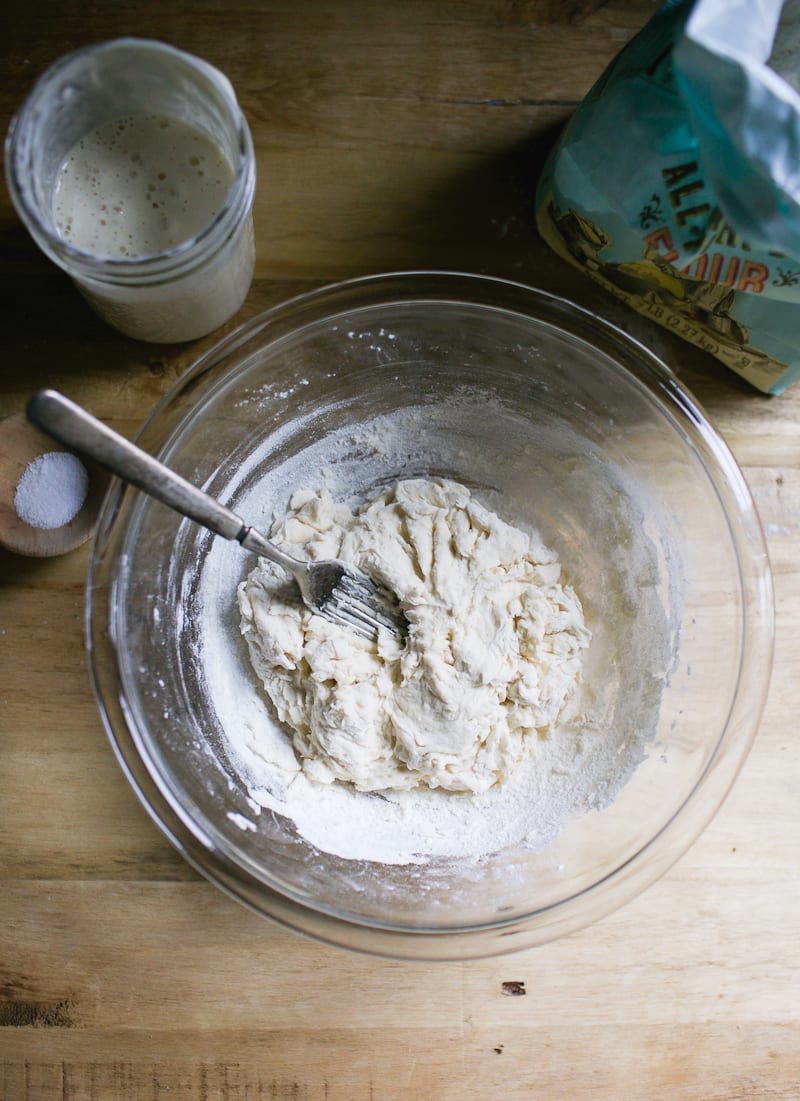
A Few Notes: This recipe makes a small sourdough loaf, perfect for 2-4 people. I prefer smaller loaves for beginners as they are more manageable to handle. Instructions for a larger, standard size are included in the recipe at the end of this post. For baking tools, please visit my shop. You will need a digital kitchen scale to weigh your ingredients (for accuracy and best results) and a Dutch oven for baking (or another oven-safe pot with lid).
Mix the Dough
In a large bowl, whisk the starter and water together. Add the flour and salt. Mix with a fork to combine.
Once it becomes too stiff to continue, finish mixing by hand until a rough and shaggy dough forms.
This is what the dough should look like after you’ve finished mixing it…
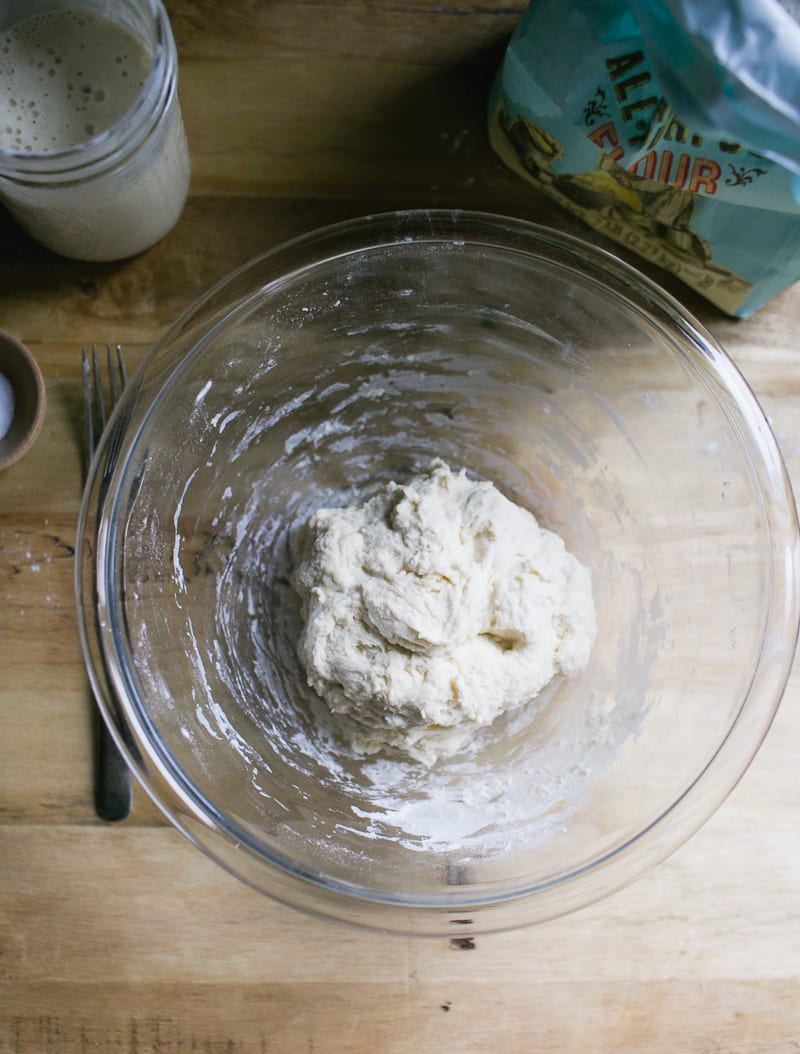
Now, cover the bowl with a damp towel or plastic wrap and let rest at room temperature for 30 minutes.
After the dough has rested…
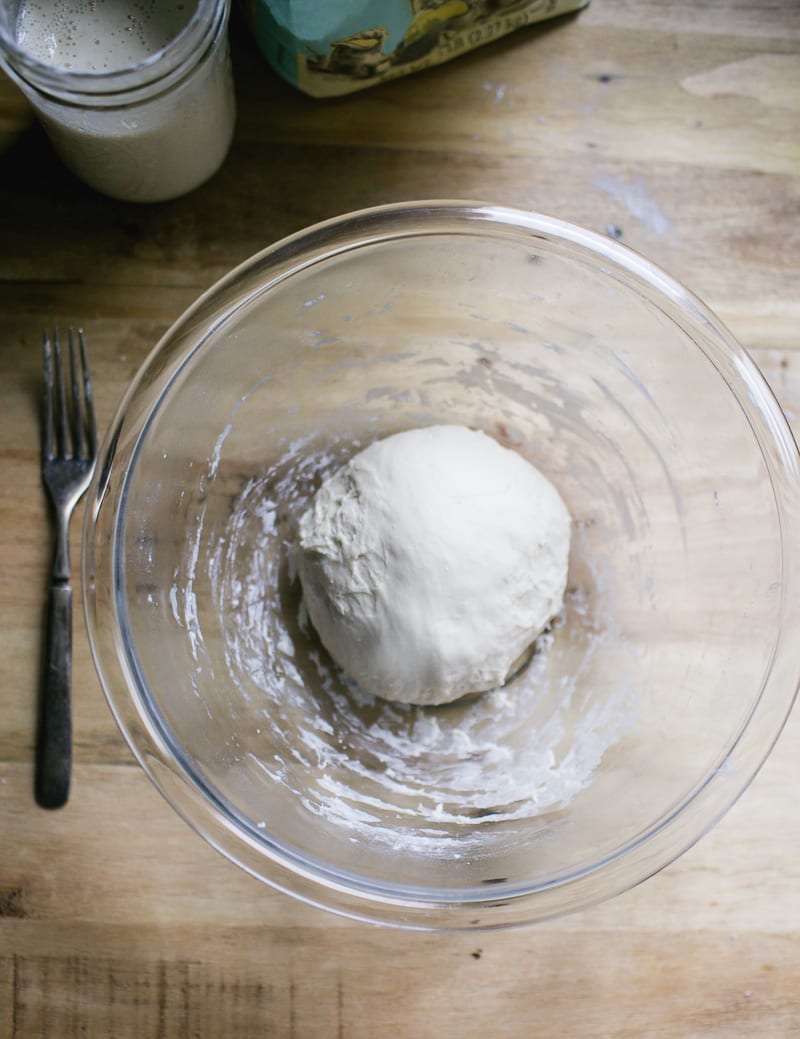
Work the dough into a ball. It will appear smooth on the surface with a few tears.
Heads up: this is your last chance to significantly adjust the texture of the dough. So take note of how it feels!
At this point, the dough should feel soft and stretchy… not wet, overly sticky, or soupy.
TIP: If the dough feels too wet (and this can happen depending on the brand of flour you’re using), add 1 tbsp. of flour after the first 30 minute rest. Mix thoroughly by hand, adding more flour as needed. If you think it’s too dry, add 1 tbsp. of water and see how you go. Not so bad right? Just a little back and forth until it “feels right.” You can’t really mess it up.
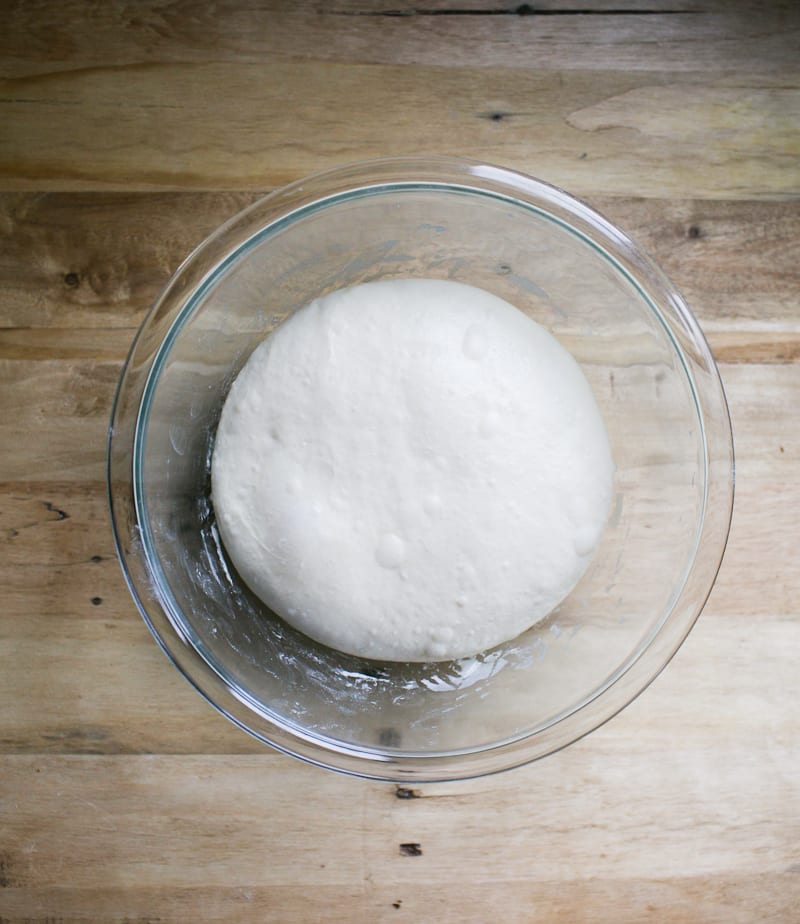
Bulk Rise
Cover the bowl and let rise overnight, about 10-12 hrs. at room temperature (68 F). The dough is ready when it has doubled in size.
TIP: If using a standard 8-inch mixing bowl (pictured above), the dough should rise to about 1/2- 2/3’s up the sides when ready (remember, this is a small loaf).
Stretch And Fold The Dough
This technique is optional and is done during the bulk rise.
It will strengthen the gluten, incorporate air into the dough and add height to the finished loaf.
To begin, about 30 minutes to 1 hour into the bulk rise, start your first stretch and fold.
Grab a portion of the dough and stretch it upwards. Then fold it over towards the center of the dough. Give the bowl a one-quarter turn and repeat (stretching the dough upwards and then folding it over) until you have come full circle to complete 4 folds or 1 set. Do another set about 30 minutes to 1 hour later.
Here’s a video!
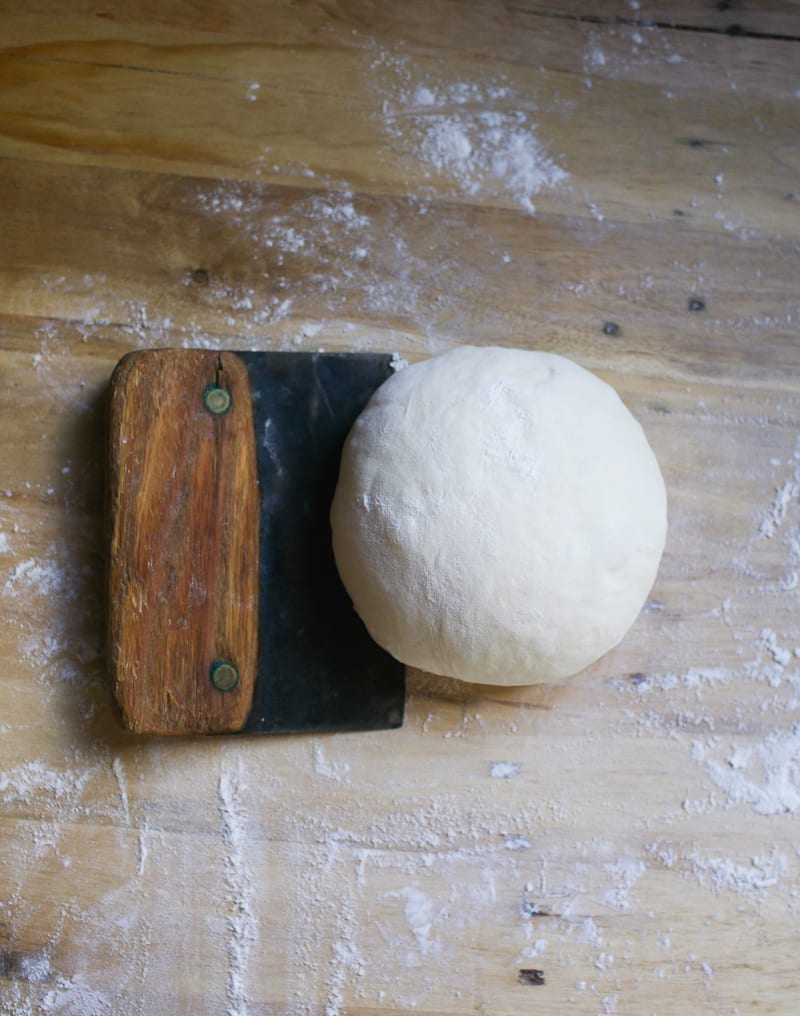
Shape the Dough
The following morning, line a small bowl with a cotton or linen cloth. Sprinkle with flour.
You’re going to shape the dough twice to build extra strength.
Preshape
Remove the dough onto a floured surface. To shape the dough into a round, starting at the top, gently fold the dough over toward the center. Give it a turn and fold over the next section. Repeat until you have come full circle.
Using a bench knife, scoop up the dough and flip it over (the smooth side should be facing up). Cover and rest for 20-30 minutes.
Final Shape
After the dough has rested, flip it over again (the smooth side should be facing down now). Shape it again following the steps above. Flip it back over.
With floured hands, gently cup the dough and pull it toward you in a circular motion to tighten its shape.
Place the dough into the lined bowl, seam side up. Cover the dough with the cloth overhang.
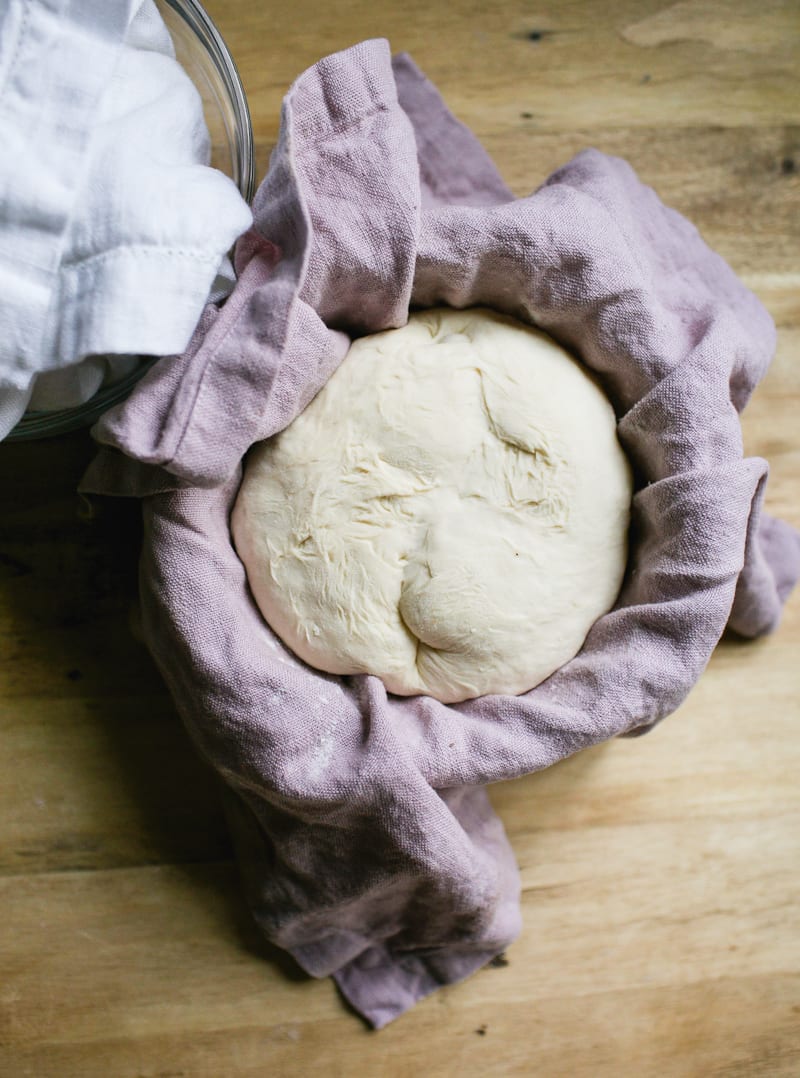
Second Rise
Now the dough needs to rise again.
Rest at room temperature for 30 minutes to 1 hour; the dough is ready when it has puffed up and looks plump. It does not double in size.
Preheat the oven to 450 F.
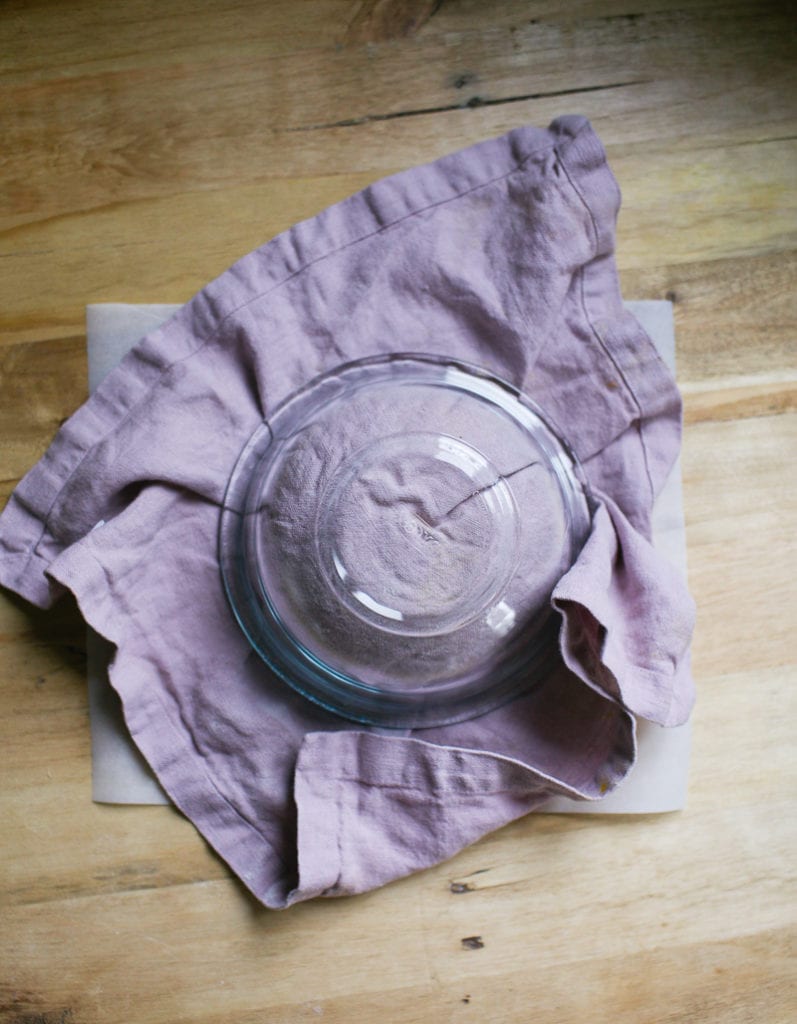
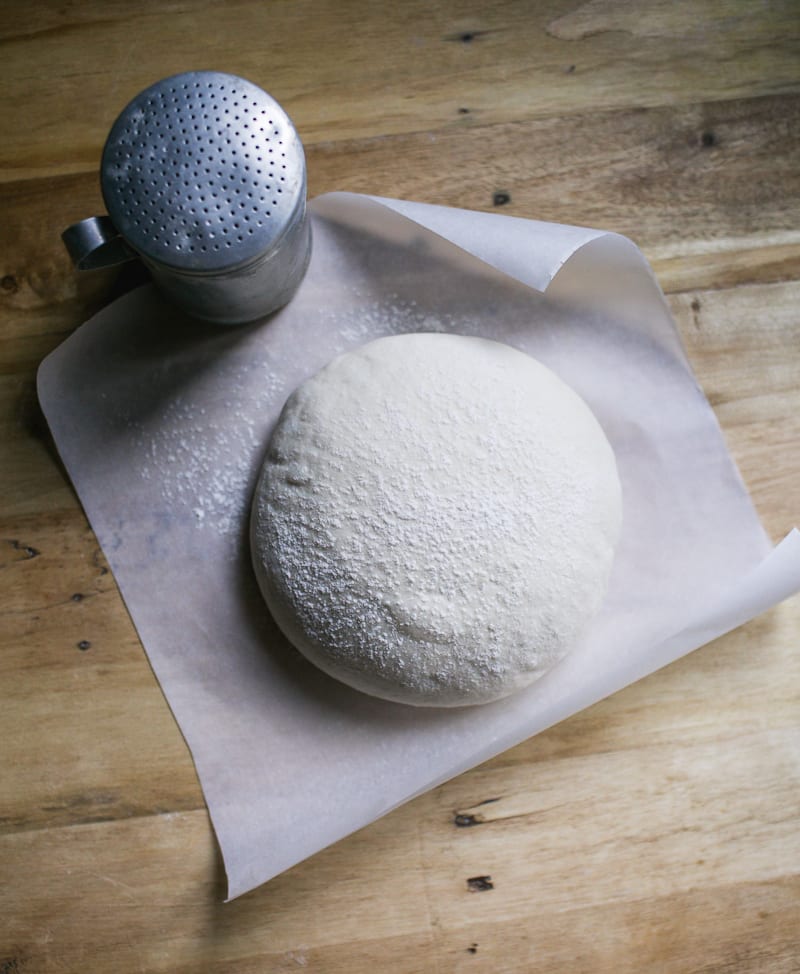
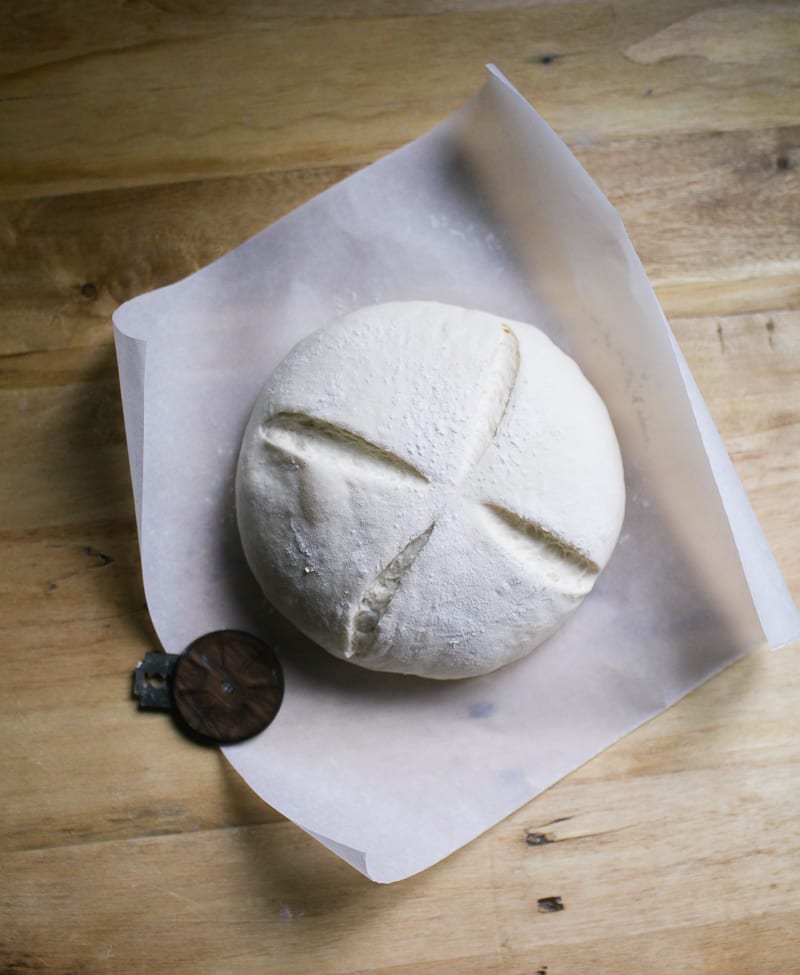
Score the Dough
Invert the bowl of dough onto a sheet of parchment paper. Remove the bowl and cloth.
Sprinkle the dough with flour and smooth the surface with your hands.
Using a bread lame or a small serrated knife (I used my UFO lame), score the dough at 12, 3, 6 and 9 o’clock, turning the parchment paper as you go. Make quick, decisive cuts using the tip of the blade.
Here’s a video!
Lift up the dough while still on the parchment paper, and place it into a Dutch oven. Pop the lid on top.
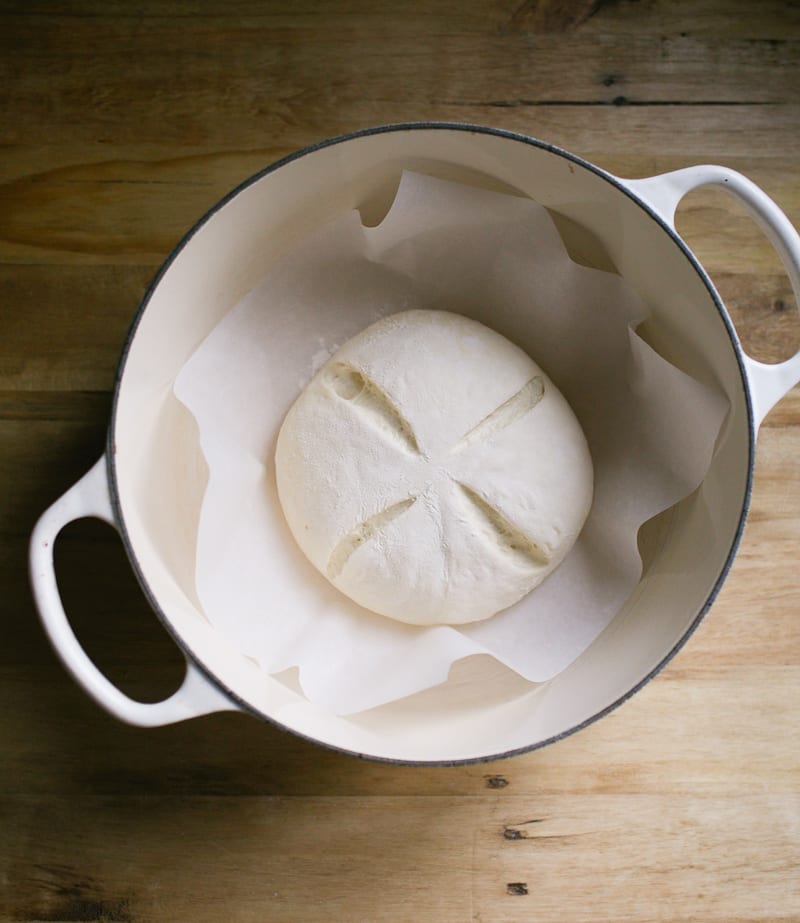
Bake the Dough
Place the pot into the preheated oven, center rack. Reduce the heat to 425 F.
Bake the dough, with the lid on for 20 minutes. Then, remove the lid and bake for an additional 30-35 minutes or until golden brown.
Here’s what the dough will look like after you take off the lid (please ignore my sparkling oven…).
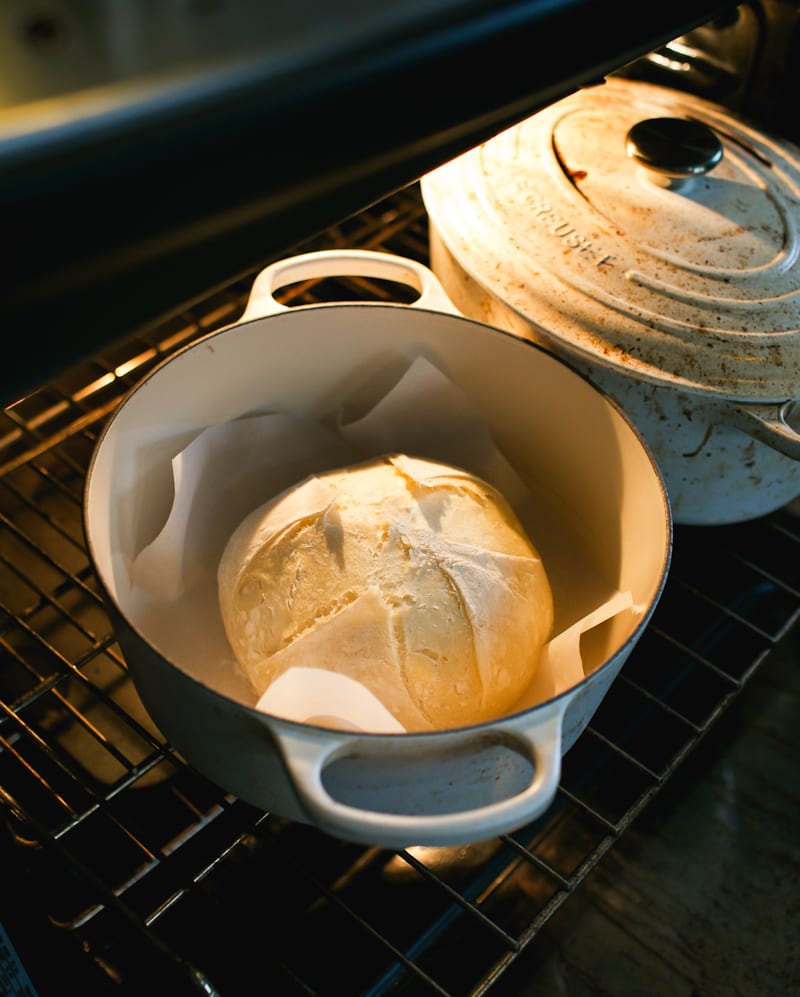
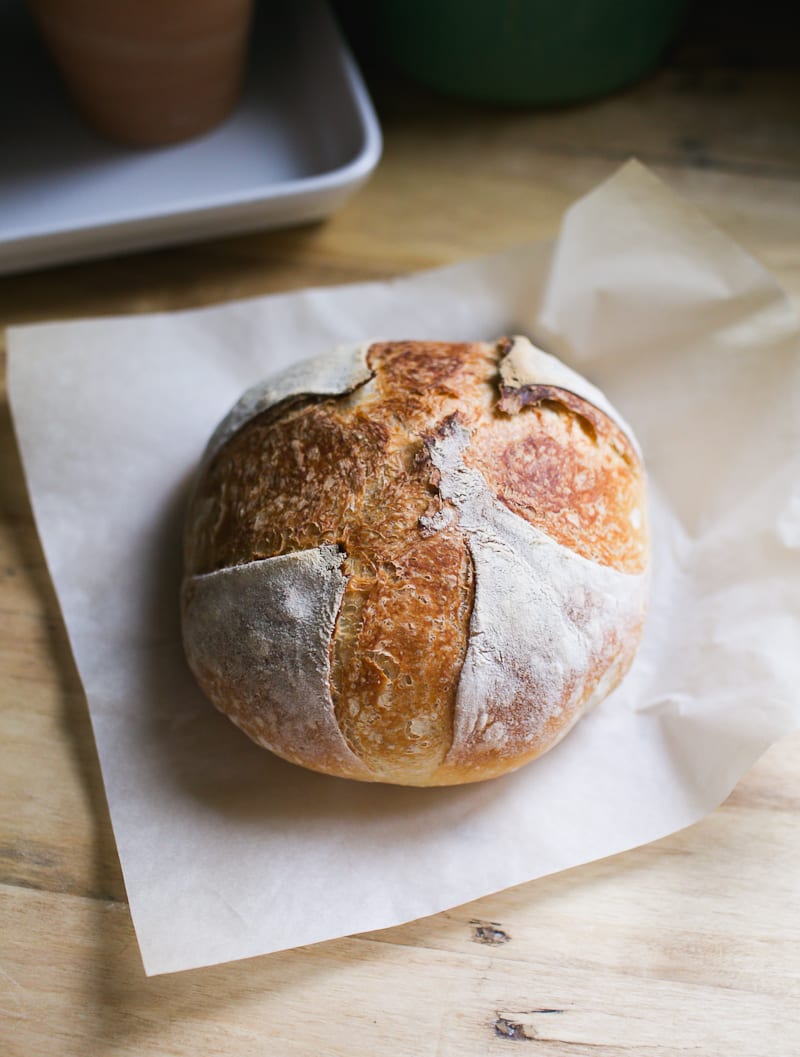
Let it Cool
Check out that oven spring!
Don’t you just want to rip off a chunk?
Unfortunately, you’ll have to wait at least an hour my friends. The texture might be gummy and wet if you jump the gun.
Storage
Sourdough is best enjoyed on the same day it’s baked.
To maximize freshness, cool completely and store at room temperature wrapped in plastic, reusable beeswax wrap or a bread bag for 1-2 days.
Sourdough can also be frozen, for up to 2-3 months. Defrost at room temperature and warm @ 300 F before serving.
Taste Test
This artisan sourdough with all purpose flour produces a crusty loaf with a smooth interior crumb.
We love it for sandwiches, french toast and crostini. It’s a versatile everyday option.
And in comparison to a bread flour loaf, none of us could really tell the difference!
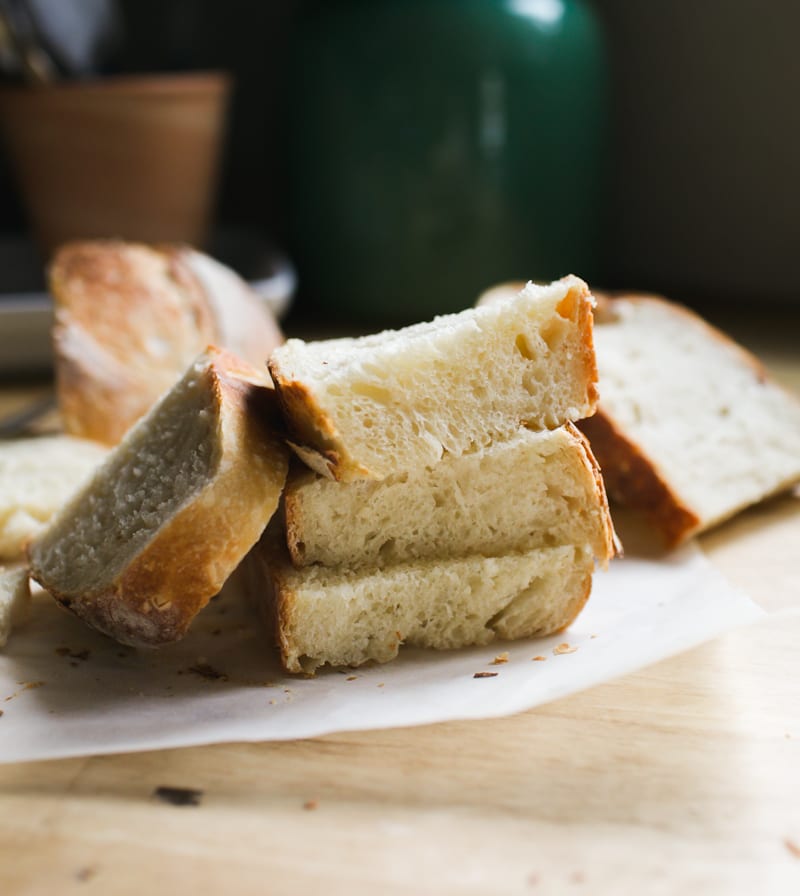
My Baking Schedule
All bakers need somewhat of a game plan before diving in.
Here’s what I do: I’ll make the dough in the evening to rise overnight (start the night before). It will be ready to bake the following morning. If it’s warmer than 68 F, I’ll start later in the evening to avoid over proofed dough. The timing is flexible.
In the evening…
- 7:00 PM: Make the dough/ Rest for 30 minutes to 1 hr.
- 8:00 PM: 1st Stretch & Fold (optional)
- 9:00 PM: 2nd Stretch & Fold (optional)
- Cover bowl with plastic wrap and let rise overnight on the kitchen counter, for 10-12 hrs @ 68 F.
The following morning…
- 7:00 AM (or earlier): Check the dough. Give it more time to rise, if needed.
- 7:05-ish AM: Preshape
- 7:30 AM: Shape
- 7:35 AM: Second Rise/ Preheat Oven
- 8:05-ish AM: Bake
Additional Resources
- How to Stretch and Fold Sourdough {Video}
- How to Shape a Round Sourdough Boule {Video}
- Artisan Sourdough Made Simple {Book}
- Sourdough Bread: a Beginner’s Guide {Recipe}
- Light Whole Wheat Sourdough Bread {Recipe}
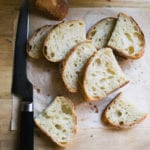
Artisan Sourdough with All Purpose Flour {soft, crisp & chewy!}
- Cook Time: 50 minutes
- Total Time: 50 minutes
- Yield: 1 small loaf (2-4 ppl)
- Category: Sourdough Bread
- Method: Oven-Baked
- Cuisine: American
- Diet: Vegetarian
Description
No bread flour? No problem! My artisan sourdough with all purpose flour is an excellent substitute. This recipe yields a smaller sized loaf (perfect for up to 4 people) with a crisp crust and a smooth, interior crumb.
Notes & Substitutions
This recipe was formulated to work with King Arthur & Trader Joe’s all purpose flour, which contains 11.7% protein. If using another brand, please see my tip in the recipe below for adjusting the texture of the dough, if needed.
For accuracy and best results: please weigh your ingredients using a kitchen scale.
Ingredients
For a small loaf:
- 50 g (1/4 cup) bubbly, active sourdough starter
- 165 g (1/2 cup + 3 tbsp) water
- 5 g (1 tsp) fine sea salt
- 250 g (2 cups + 1 tbsp) all purpose flour (Trader Joe or King Arthur)
For a larger, standard size loaf:
- 50 g (1/4 cup) bubbly, active sourdough starter*
- 330 g (1 1/3 cup + 1 tbsp) water
- 9 g (1 1/2 tsp) fine sea salt
- 500 g (4 1/4 cups) all purpose flour (Trader Joe or King Arthur)
*Note: I use 50 g of starter for both the small AND standard size loaf. Using a smaller amount of starter with an long, overnight rise will help to prevent over proofed dough in the morning.
Instructions
Make the Dough
In the evening, whisk the starter and water together in a large bowl. Add the flour and salt. Mix with a fork until a stiff dough forms, then finish by hand to fully incorporate the flour. It will feel rough and shaggy, and slightly sticky. Cover with a damp towel or plastic wrap and let rest at room temperature (68 F) for 30 minutes.
After the dough has rested, work the dough into a ball. To do this, grab a portion of the dough and fold it over, pressing your fingertips into the center. Repeat, working your way around the dough until it begins to tighten.
TIP: If the dough feels too wet (and this can happen depending on the brand of flour you’re using), add 1 tbsp. of flour. Mix thoroughly by hand, adding more flour as needed. If you think it’s too dry, add 1 tbsp. of water and see how you go.
Bulk Rise
Cover the bowl (damp towel or plastic wrap) and let rise overnight at room temperature. This will take about 10 to 12 hours at 68 F. The dough is ready when it no longer looks dense and has doubled in size. If using a standard 8-inch bowl, the dough will rise about 1/2 way up the sides.
Optional Step: about 1 hour into the bulk rise, do 1 set of stretch and folds. Repeat 1 hour later. This will increase the overall volume of the bread.
Shape the Dough
The following morning, line a small bowl with a cotton or linen cloth. Sprinkle with flour.
Important: You’re going to shape the dough twice to build extra strength.
Preshape
Remove the dough onto a floured surface. To shape the dough into a round, starting at the top, gently fold the dough over toward the center. Give it a turn and fold over the next section. Repeat until you have come full circle. Using a bench knife, scoop up the dough and flip it over (the smooth side should be facing up). Cover and rest for 20-30 minutes.
Final Shape
After the dough has rested, flip it over again (the smooth side should be facing down now). Shape it again following the steps above. Flip it back over. With floured hands, gently cup the dough and pull it toward you in a circular motion to tighten its shape.
Place the dough into the lined bowl, seam side up. Cover the dough with the cloth overhang.
Second Rise
The dough needs to rise again. Rest for 30 minutes to 1 hour. The dough is ready when it looks puffy and has risen slightly, but has not yet doubled in size.
Preheat your oven to 450. Cut a sheet of non-stick parchment paper to fit the size of your baking pot, leaving enough excess around the sides to remove the bread.
Score the Dough
Place the parchment over the dough and invert the bowl to release. Sprinkle the dough with flour and gently rub the surface with your hands. Using the tip of a bread lame, small, serrated knife or a razor blade, make four shallow 4-inch long cuts at 3, 6, 9, and 12 o’clock around the dough. Use the parchment paper to transfer the dough to the baking pot.
Bake the Dough
Reduce the heat to 425 F. Bake the dough on the center rack for 20 minutes, covered. Remove the lid, and continue to bake for 30-35 minutes and golden brown (40 minutes uncovered for the larger, standard loaf).
When finished, transfer to a wire rack. Cool for 1 hour before slicing, for best texture.
Notes
Sourdough is best consumed on the same day it is baked. To maximize freshness, cool completely and store at room temperature wrapped in plastic, reusable beeswax wrap or bread bag for 1-2 days.
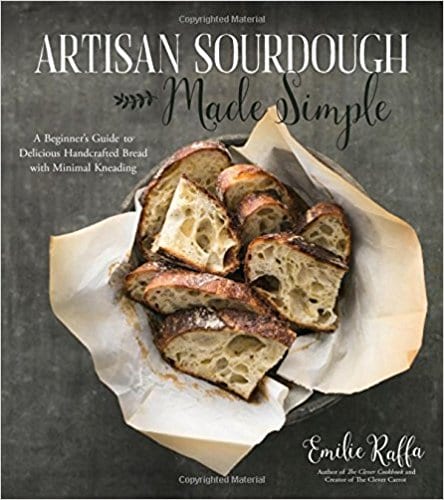

Comments
Beverly says
First time baking sourdough bread and used this recipe only. Great results every time! Thanks for the step by step recipe!
Anastasiia dH says
What a fantastic recipe!
As an absolute sourdough beginner few months ago, I created my own starter (following your recipe) and have been using your bread recipe ever since!
It only took me a few attempts and adjustments to have a set routine and a perfect sourdough bread every time!
Today I going try out your sourdough focaccia recipe, and I am so excited!
Meghan says
Your blog has been so helpful throughout my almost 2 years of baking sourdough (and cookies and waffles and pancakes, etc). My friend shared your site with me, and now I share it with everyone who asks me about how to bake it! Thank you so much for sharing your wisdom – I genuinely appreciate your hard work!
Bev says
First time making starter and bread! Turned out delicious. Thanks for the recipe and the instructions
Jessie says
Hello,
My family and I absolutely love this recipe. I appreciate that I don’t have to purchase bread flour to have amazing homemade bread.
Any chance anyone knows how to use this recipe with an all purpose gluten free flour? My 5 year old was just diagnosed with Type 1 diabetes and tested positive for celiac disease. We’re not to take her off all gluten so I was thinking of using my good homemade starter and a combination of all purpose and gluten free. Obviously I would then work a slice into her allotted carbs. I feel like I’m asking for a miracle though.
She’s been through so much and during our four day stay in the hospital she said she missed my bread. So now I’m on a mission. Any information is appreciated.
Amanda says
If you long ferment bread it significantly reduces gluten (if not eliminates it!). You just put the final dough in the fridge for up to 72 hours before baking. I’m no pro (ha!), so perhaps ask Google to confirm. I have long-fermented this recipe for 24 hours and it was amazing. I have severe eczema and cannot have gluten and my skin did not react. Next time I am going to try fermenting a bit longer (48hrs!).
Jessie says
My husband is gluten intolerant, not an allergy or celiac, and doing a long ferment (48 hrs) on a loaf enables him to eat a slice each day with very few/no symptoms. Hope you find something that works!
Wendy says
I love this recipe, it turns out great and is so tasty! The last few times I’ve made it, it looks fabulous when I take it out of the oven but when it cools there are air bubbles between the crust and the bread. What am I doing wrong? Thank you so much!
Karli Thompson says
This is my absolute favorite! I use this recipe and follow another person’s directions for proofing and baking in my instapot! So so delicious! Currently making 3 extra loaves to share with my family!
Emilie Raffa says
Karli, that sounds so cool. I’ve never baked bread in an instapot. So glad it worked!
Annie says
This recipe is delicious, super easy even for a first-time sourdough baker like me, and very forgiving. The first time I made it, I followed the instructions exactly and it came out perfectly. The second time, I got interrupted and ended up storing it for hours in the refrigerator between rises and then again overnight before baking. Of my two small breads, one ended up baking covered for too long and then I had to guess at the uncovered baking time. Everything was still pretty perfect and delicious. This is going to be a go-to for me to have fresh bread around all the time, at least until I finish a huge bag of AP flour and move on to other things.
Alison says
Hi! I was looking for a comment about baking in the evening. Do you put the dough in the fridge so that it doesn’t overproof or is it fine on the counter all day? Thanks!
Annie says
When I knew I was going to be delayed by hours during the later phases (second rise, after final shaping, etc.) I put it in the fridge to avoid overproofing, with great results. However, this recipe calls for a bulk rise for 10 to 12 hours. So you could definitely feed the starter at night, mix the dough in the morning, bulk rise on the counter all day, and then do the final steps and bake in the evening, no refrigeration needed. In other words, one long, room-temperature rise is part of the recipe. I put it in the fridge to avoid a second and third long rise later in the process. Hope that makes sense!
Alison says
Thank you so much! I appreciate your response!☺️
Alesha Daniels says
If using King Arthur bread flour how many gram or flour & water would it be?
Elizabeth says
This is the recipe I use almost exclusively. It is so good and so easy and the weights are perfect! Love it so much I purchased the cookbook and have found the recipes in the cookbook just as great! I usually feed my starter at night, form the dough in the morning before work, and bake in the evening. Perfect for someone who works outside the home. Thank you!
Judy says
Can the loaf be baked on a baking sheet? I don’t have a dutch oven.
Rachel Busby says
Hi! I have successfully made this once and it turned out great! I am working on doubling the recipe tonight. Question, should my hands be covered in dough after the initial mixing of the flour and water/sourdough? They have been both times.
Elle says
My first batch of starter was on the stove and I ran the broiler and didn’t realize it would get so hot it would kill it! Eeek! Burnt and horrid. Lesson learned. So I had to wait a second week to try this. Fast forward to week two, new starter. I made this recipe followed to a T. But it’s so cold and dry here the top of the dough became hard after the 18 hr rise (it didn’t rise after 10 or 12 hrs!) (it’s -2 and the house just can’t a get warm!) I wasn’t going to waste it so I folded it in and hoped. Then for the second fold I did the same. And prayed.
Omg it worked and seriously this is the best bread I’ve ever made! I’ve done the artisan in 5 min bread for years. My ex-SO made real hard core multi grain specially ground flour sourdough all the time. Not as good as this recipe. Truly! Wowowow! Even my pup went crazy for a slice. Thank you! So nice to have a sweet tiny loaf for one person too! Though if I wasn’t gorging on it maybe it would be a good size for 2-3!
Una says
I had always wanted to make my own sourdough starter and was delighted to find the clever carrot! I am a rookie baker and have been using this recipe for about 8 weeks now resulting in delicious bread! However, my last two loaves have had a 1-1.5 inch gap between the bread and the crust once I slice into it 😭 I don’t know what I’m doing wrong as I haven’t changed my technique or oven temperature etc. I’m wondering if it’s an issue with the starter?! I really don’t know! Any tips from experienced bakers? Thank you
Sherry says
Sounds like it could have been overproofed! Sourdough doesn’t need to fully double in size during bulk fermentation. Increasing by 1/2 or 2/3 is generally enough. Try that and see if it helps!
Shanelle says
Hi there- after many failed attempts at various artisan bread recipes, this one was a huge success!! YAY! Thanks! Everything I make of yours turns out. One question, I was hoping the bread would be more “sour”–it was a little tasteless in my opinon, anyways to help the sour flavor along? (I followed all directions EXACTLY).
Molly says
After shaping the dough you can put it in the fridge to proof/develop flavor overnight. Make the dough and bulk rise during the day
Zenia says
Love this so much that I’m making multiple loaves! Quick question- I only have one Dutch oven. Can I bake the second loaf at the same time uncovered OR do you think it will be ok waiting until the first loaf is done to be baked? Thanks!
Annie says
This recipe is very forgiving, you can definitely just bake in your dutch oven one at a time. That’s what I did yesterday and it was totally fine. I think that baking covered in the dutch oven provides a period of increased steam so that the bread gets to rise more before starting to form a crust, so you get a bigger loaf. If you bake uncovered you might get a slightly less risen loaf (though I bet it would still be good).
Becky says
I love this recipe! It makes the best easy bread! What size bowl do you suggest when making the double loaf, for the final shape?
Erin says
This recipe is lights out the BEST! First timer here. Followed the steps exactly and it came out perfectly. My daughter said it’s the best bread EVER and I agree. Thank you!
Joyce says
Just made this and it was beautiful! The flavor is incredible and well balanced. My only issue was that my dough didn’t rise that much, so my sourdough was really flat. I’m trying to troubleshoot what went wrong, but I followed all the steps. My house temperature was 70 degrees and my starter passed the float test. My dough was initially on the stickier/wetter side so I added a tablespoon of flour and that helped. Any idea what I could’ve done wrong?
Jamae Lacey says
Did you make the large loaf or the small loaf? I find with the large loaf it takes foreverrrr to rise, so I usually do 100g starter and it rises more routinely.
Joyce says
I made the small loaf and it was tiny because it didn’t rise properly. But it still tasted good!
Jamae Lacey says
Did you do the stretch and folds? That increases the overall volume. Did you let it proof too long? Maximum should be doubled in size, a little bit under double is ideal. Did you shape it really tightly before putting it in the oven? It should be darn near a perfect circle before scoring. I hope this helps!!
Elizabeth says
Thank you! I’ve tried numerous recipes and this one is by far the easiest and best. Came out beautiful! Thank you for using the word “optional “ on the stretch and fold. I didn’t do it and no problem! I reversed the schedule and formed my dough before leaving for work in the am and baked in the evening. Used my instant pot trivet in Dutch oven to prevent burning as one reviewer suggested. Beautiful rounded bottom and high oven spring. Thank you for not making me heat the oven for an hour and for not requiring preheat of the Dutch oven. This recipe makes sourdough bread on a weekday SO easy. I will be getting your cookbook.
Amanda says
HI! super new and cant wait to dive in with all your info/recipes! I looking to use this recipe but would like to make two loafs so would I just double the recipe and then divide the dough? And secondly if thats the case but I only have one vessel to bake in, what point do I put the second loaf in the fridge while it waits for its turn in the over, after the final shape, or after the second rise?? Thanks so much!
Emilie Raffa says
Hi Amanda! Yes: double the recipe and divide the dough after the bulk rise. For the 2nd dough, after the final shape, place it in the fridge for the second rise (in the meantime, your fist dough will be in the oven). Hope this makes sense!
Amanda Moulton says
It does! Thanks so much!!
Kiko says
Great recipe! For whatever reason, my bread turned out better with this recipe using bread flour compared to using bread flour with your other recipe made for bread flour. Either way, both recipes are new favorites at my home. Thank you!
Andrea says
This is such a great recipe… I’ve made it several times with all purpose and with bread flour. With the all purpose it is a little more playing with the texture to get it where you want it. Much easier with bread flour. There’s another site that talks all about sourdough and shows you the difference when you over proof or don’t knead enough or use too much water to show the results – what the crumb looks like and how the taste is different. Too sour – sourdough doesn’t mean you’ve done it right. It is an art so practice practice… it definitely gets easier. Weight measurements and getting a feel for what the dough should feel like will allow you to not stress so much during the process.
Yulia says
Hi Emilie. I have baked your bread 3 times and all the times it came out great. No issues whatsoever. I only have a question that confuses me the most. After I shaped my bread, why can’t I place the dough into the fridge for let’s say up to 36 hours for a cold proof? Some suggest that it can be in the fridge for that long to attain the sour flavor. I’m wondering if I can do it with your recipe. Maybe 12 hours or 24? Or is it not needed? Thank you.
Susan says
Can you use bread flour for this recipe?
Ann says
Thank you so much. 🌹
If I choose to start in the morning, after final shaping can I place in refrigerator and bake it the next day?
If so can it go directly into oven or does it need to sit out a bit before baking?
Tia.
Katie says
This makes the best sourdough bread I’ve ever tasted and it was pretty simple! Thank you
Sharon says
Can you send me the nutrition value and and how many grams. I need to know carbs in the calories. I made this recipe yesterday in my Dutch oven and it turned out fabulous thank you.
Dani says
What if you don’t have a dutch oven pot? Can you use another pot instead?
Jamie says
I made this using cups to measure the ingredients and then using a scale and weighted measurement. The weight measurement is highly superior, fluffier and a lighter crispy crust! Wonderful recipe.
Emilie Raffa says
Hi Jamie! Agreed. In bread baking, you’ll get better results when the ingredients are weighed, rather than measured. It’s more accurate. The flour to water ratio is incredibly important for best texture!
Erin says
Hello! Is the large loaf recipe easily doubled to make two large loaves at once? Would separate the dough into 2 loaves just before forming the dough in the morning. Wondering especially about the amount of starter that would be used for this.
Jackie says
My first time making sourdough. I thought it was going to be a disaster as my dough was sooo sticky in the morning after letting it rest, but i sprinkled rice flour on the surface. Then my toddler pulled the dough out of the tea towel and it looked deflated. I baked it anyway and it actually came our really good!! Very crunchy crust and the inside had nice air pockets, was moist ans delicious. I couldn’t slice much on the top as it was still extremely sticky. It’s a miracle it turned out. This is an excellent recipe and I can’t wait to play around with it abit next time.
Ed says
This is a wonderful recipe along with your instructions for making a sourdough starter. My first loaf was so so, the second pretty good and the third excellent. In between making bread I studied your YouTube along with that from proofbread an all sourdough bakery in Mesa, Az. Each time you watch you pick up a little more information. Little things like tips or techniques. This recipe produces great bread and I’m anxious to try and expand my use of sourdough. Thank you.
Ashley says
This is a great recipe. I have never made sourdough bread before, but it turned out great, and my family loved it. I will use it again.
Beth Rice says
I love this recipe and the simplicity of it. BUT, the bottom of my bread ALWAYS burns…how can I keep that from happening?
Tyler says
Hi Beth! I have had this problem as well. Someone previously asked this and Emilie replied with some tips:
This is actually extremely common. Could be your oven, could be the type of pot you’re using, could be the placement of the pot etc. To remedy this, first use an oven thermometer to determine the exact temp of your oven. Then, place a cookie sheet on the rack below your baking pot (not underneath it); this will shield the heat from the bottom up which should prevent a burnt crust.
LarV says
I put my Instant Pot wire trivet in the bottom of the Dutch oven and put the parchment and dough on top of that. Worked great! No more too-dark bottoms!
Elizabeth says
Thank you for this tip! I did this and it came out perfect!!
Hannah says
I’ve tried this recipe once already with moderate success, so I’m excited to try again and make it even better. I just got a starter a month ago so I’m still learning how to make a good sourdough.
What I like about this recipe is how comprehensive it is, as the step-by-step combined with the pictures make for a clear recipe. I like that a schedule is included, and there is a “long” recipe version and a “short” recipe version. I will be remaking today.
StellarJay says
This recipe was handed down along with the starter from a kind neighbor & Sourdough enthusiast. It turned out amazing on the first try. The internet is saturated with recipes. I am as thankful for receiving this recipe as I am for the gifted starter. No kneading, simple & delicious recipe. IMO Perfect!!! Thank You Clever Carrot
Kristine says
I’m a newbie at baking sourdough bread- this recipe resulted in a fluffy loaf! I was elated to finally achieve the texture I was hoping for!
Railya says
I made my first perfect sourdough following your recipe. Thank you. The bread turned out amazing!
Emilie Raffa says
Excellent, Railya! So great to hear. Enjoy and happy baking :)
Bhagya Hettiarachchi says
Instead of using all-purpose flour, can I swap it for bread flour?
Emilie Raffa says
Sure, bread flour will work. Depending on the brand, you might want to increase the overall amount of water in the dough so it’s not too dry.
Lars Jeppesen says
Perfect on my first try; I tagged you in my IG and FB posts with photos. Thanks for sharing with kindness https://www.instagram.com/larsjeppesen/
ken says
In other recipes the dutch oven is preheated, but not here. Would that cause problems if it was preheated?
Emilie Raffa says
Not at all. If you prefer to preheat, you’re more than welcome to do so for this recipe.
Adam Hetherington says
I have a feeling I overproofed the dough. I let the bulk go around 14 hours because I was waiting for the dough to double in volume. I stopped the bulk short of doubling. When I dumped out the dough on the counter is was very sticky and slack. I’m going to keep going but do you have any suggestions for why this is happening and what I should change. Overnight temp was around 70F. Thanks!
Pamela F. says
Hi! I have made numerous batards using your beginner’s sourdough recipe. They have come out perfectly. Why do you not use olive oil in the AP flour recipe? (I’m out of bread flour.)
Swati says
Hi. I have many questions.
There is no oil in this recipe. Any reason? Also can I leave the dough to rise in an oiled bowl. Since It becomes very warm here during summers, if I start the process early morning, can I bake the same day. Do I need to increase the amount of starter. I have a very active starter🙂
Emilie Raffa says
Hi there! Oil is optional; my ap flour sourdough is a different recipe for variety. Oil changes the texture of the crumb and crust (see which one you like best!). Totally fine re: oiled bowl to rise the dough. And yes: bulk rise during the morning/day and chill the whole bowl overnight, or when you’re ready to bake later in the day. You do not need to increase the quantity of starter for a same day bake in hot weather.
Gary says
Use 20-30g less water… Don’t let it quite double in size during bulk rise.
Dagmar's Dough says
This came out perfect. Thank you so much for the All Purpose flour recipe.
Trish Chalmers, Trish’s Dish’s says
Hey first time making sour dough so did the small loaf. Had fun with some ups and downs. Thought my starter was non active, yet stuck with it and rising happened!!! Can’t lose faith! Starter is growing to as I am now feeding it to tackle a big loaf!! In Mexico and had no cast iron, so used Pyrex with lid and it worked. Will use cast iron for large loaf and reg oven!!
Proud maker!!! Trish of Trish’s Dish’s. Here’s a pick!!
Katherine says
Hello there, thank you for sharing this recipe, I love how simple it is to follow. I tried to search through the comments to see if I can find answers, but I’m not sure if the feature is available.
I’m on my 3rd round of trying this recipe and my dough has been really sticky each time. I use King Arthur flour and there is a good rise at about 10 hours at about 68 degrees fahrenheit, but the dough will flatten before it’s bake time. Do you have any suggestions? Please and thank you =)
Luke says
Your comment is what I was thinking would happen in my case if I followed this recipe. Your dough is likely way over proofed. Dough should be “on the rise” not the fall to get a good oven spring, and if I were to leave my dough out overnight with my sourdough starters it would be way over proofed by the morning. You could try adjusting the amount of starter you use by half to see if that helps, or you can do your bulk proof in the fridge (after shaping the dough) to avoid over proofing your dough. In that case, you’d want to possibly increase the starter size and bulk ferment so you are closer to where you want to be before shaping and placing in the fridge.
Rowan Skinner says
hi there,
i was wondering if i can use whole wheat instead of all purpose flour?
Emilie Raffa says
Hi there! I wouldn’t do an even swap; whole wheat flour absorbs more water than reg. white flour, and in some cases, the dough will become more dry. It will change the entire texture of the finished bread. You can read more here.
As an alternative to this recipe, I would try my Light Whole Wheat Sourdough. Enjoy!